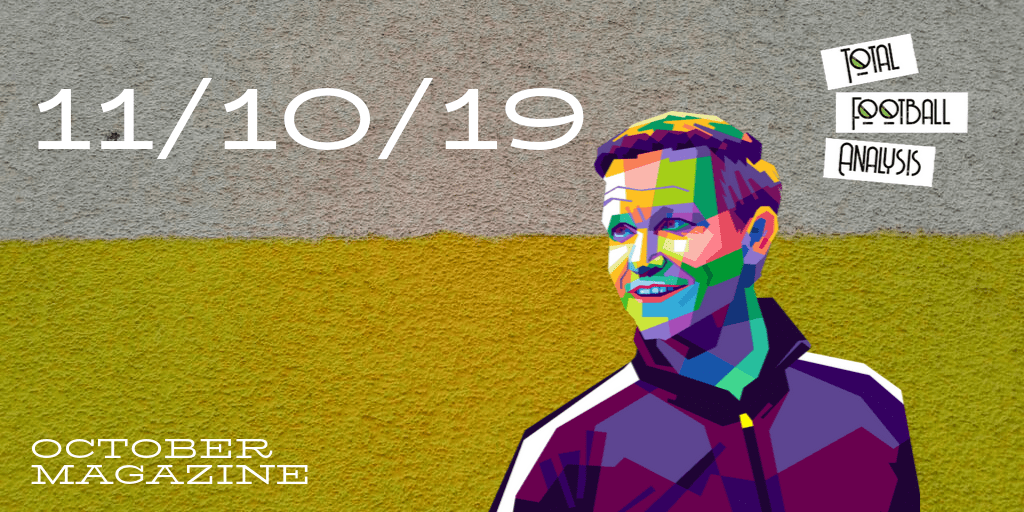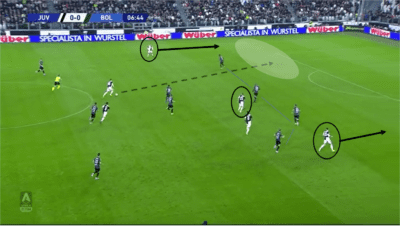Upon their return from the international break, Juventus triumphed to a 2-1 win over an impressive Bologna side that has been catching the eyes of many pundits and analysts alike so far in Serie A this season.
Before the game, it was hard to predict just quite how this game would go with Bologna, statistically leading the league in xP (expected points) after boasting the second-best xG (expected goals) in the league, at 15.4 (Juventus ranking only 9th in this statistic, with 11.26). Both sides returned from their international duties to put out rotated lineups and in the end, the quality of depth in Juve’s squad helped to overpower the away side.
This tactical analysis piece will examine the tactics used during this featured clash and our analysis will highlight where both teams enjoyed success and experienced failure within this match.
Lineups
After a number of key players returned from their travels, Maurizio Sarri opted to rotate several of his starting players. As the likes of Paulo Dybala, Blaise Matuidi and Aaron Ramsey either dropped to the bench or out of the squad entirely, there were rare starts for players like Fernando Bernadeschi and Adrian Rabiot. Sarri otherwise continued with his new 4-3-1-2 formation.
Bologna were unfortunately without the thriving Takehiro Tomiyasu at right-back as well as the ferocious Gary Medel in midfield. In their places, Ibrahim Mbaye and Mattias Svanberg, adopted the starting roles. Bologna also stuck with their current formation, the 4-2-3-1.

Aware of Juve’s narrow formation, and lacking the steel of Medel in midfield, Bologna opted to forsake a high-pressing approach in favour of maintaining a compact defensive block.

This forced Juve to win the game through the talent they had in the wide areas of the field. By congesting the centre of the field, Bologna attempted to limit the space available to Juve’s midfield within their own half. In order to do this, Bologna pushed their back-line up, brought their wide men into the middle and rarely asked Soriano to push forward alongside Palacio to press the opposition.
The idea behind this, to force Juve into passing in a ‘U’ shape, primarily circulating the ball through their centre-backs and full-backs. This would help Bologna keep the game in front of their defence, compelling Juve’s creative players to receive the ball whilst dropping deep, with their backs to the goal and with little room to turn and pose any threat.
Bologna’s conservative approach reflected in their offenceDue to Juve’s offensive movement, however (which we will get into) Bologna’s compact shape was repeatedly opened up and only mildly successful at preventing Juve’s access to the centre.

Bologna just were not able keep Juve out of the centre of the field and this rendered their entire gameplan redundant. Bologna forsook a lot of their offence in order to try and nullify Juve’s own attack, however, with that being unsuccessful, this also meant Bologna posed little offensive threat to the defending champions.
Bologna hardly pressed their opposition in the opposing half and attacks (outside of set-pieces) were rarely supported by the holding midfielders. This meant Bologna rarely forced turnovers of possession inside Juve’s half with the away side only winning three tackles inside Juve’s half and forcing Sarri’s side to lose possession five times in the same area. In contrast, Juventus attempted 15 tackles inside Bologna’s half and forced the away side into losing the ball 12 times inside their own half.
This limited the opportunities Bologna had to attack and run at an unbalanced defence. So, when Bologna were on the attack (a relatively rare occurrence due to their 35% possession share) they were often attacking in underloaded situations and with little space to work with. This would help to explain Bologna’s lack of potency up-front in this game and why their only goal of the game was the result of a wonder strike from centre-back, Danilo Larangeira.
Juve’s interchanging front threeThe most prominent feature of Juve’s offence was the interchangeability and movement of their front three. Part of why Juventus were so successful at opening up space inside Bologna’s defensive shape was because of how the front three spread themselves across the width of the pitch in early phases of the attack, acting more like a traditional front three in a 4-3-3.

This had the effect of keeping Bologna’s backline honest, stretching the defence horizontally and opening up dangerous passing lanes around or through the backline. With Bernadeschi being a more natural wide-man, it was a surprise to see him lineup as a central attacking midfielder in Juve’s lineup however using the Italian in this manner made sense of his inclusion.
With the front three being so active with their movement, the Juventus backline and midfield had some easy out-balls down the channels which their front me could chase down. These direct attacks helped to put Bologna’s defence on the back foot early on in moves and force them to defend running back towards their own goal which no team is comfortable doing.
The responsibility to stretch the pitch wasn’t purely down to the front three however and after sustained periods of possession, Sarri made use of his dynamic full-back pairing. Once afforded the time, Alex Sandro and Juan Cuadrado, would advance forward and allow the frontline to return to the centre.

This had the effect of maximising the output of Juve’s frontline against this Bologna block. Overloading the centre and attacking the box in numbers allowed Gonzalo Higuain and Cristiano Ronaldo to isolate themselves against their opposing centre-backs and defending 1v1 against these two would be a tough task for any centre-back pairing.
The additional effect this had on the rest of Bologna’s defensive shape was to draw their wide men and holding midfield out of position. The holding midfield of Bologna didn’t want to leave their centre-backs alone against the Juventus front three and thus dropped deeper whilst Bologna’s wide men were compelled to track the marauding full-backs from Turin. This allowed Juve’s centre-backs to isolate the 37-year-old Rodrigo Palacio and thus free the rest of the midfield to push forward and wreak havoc inside of Bologna’s shape. It was from this side effect, that Miralem Pjanić, was able to break into the box to score Juve’s second, and winning goal of the game.
ConclusionLooking at the goals alone, one could argue that Bologna were perhaps unfortunate to leave Turin without a point, however, after looking over the statistics and seeing how Juve’s front line manipulated their defence, this has to go down as one of Bologna’s worst performances so far this season.
That’s understandable however as the away side were without two players who’ve been key to their early-season success. They were also up against the favourites for the Serie A title who have the luxury of being able to call upon an army of talent when they choose to rest certain players.
In the end, however, it was Bologna’s conservative approach that doomed them to disappointment in this game. The away side gave themselves little opportunity to win the game as they opted instead to focus their efforts on simply not losing. Against a much-changed Juventus lineup, this was an upsetting approach for Bologna’s supporters.

If you love tactical analysis, then you’ll love the digital magazines from totalfootballanalysis.com – a guaranteed 100+ pages of pure tactical analysis covering topics from the Premier League, Serie A, La Liga, Bundesliga and many, many more. Buy your copy of the October issue for just ₤4.99 here





Comments